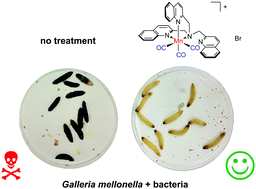Biological activity of manganese(i) tricarbonyl complexes on multidrug-resistant Gram-negative bacteria: From functional studies to in vivo activity in Galleria mellonella†
Abstract
Three new manganese(I) tricarbonyl complexes [Mn(bpqa-κ3N)(CO)3]Br, [Mn(bqpa-κ3N)(CO)3]Br, and [Mn(CO)3(tqa-κ3N)]Br as well as the previously described compound [Mn(CO)3(tpa-κ3N)]Br with bpqa = bis(2-pyridinylmethyl)(2-quinolinylmethyl)amine, bqpa = bis(2-quinolinylmethyl)(2-pyridinylmethyl)amine, tqa = tris(2-quinolinylmethyl)amine, and tpa = tris(2-pyridinylmethyl)amine were examined for their antibacterial activities on 14 different multidrug-resistant clinical isolates of Acinetobacter baumannii and Pseudomonas aeruginosa, in recognition of the current antimicrobial resistance (AMR) concerns with these pathogens. Minimal inhibitory concentrations (MIC) of the most potent tqa compound were in the mid-micromolar range and generally lower than that of the free ligand. Activity against both bacterial species increased with the number of quinolinylmethyl groups and lipophilicity in the order of tpa < bpqa < bqpa ≈ tqa, consistent with measured increases in release of ATP, a uniquely cytoplasmic biomolecule and induced permeability to exogenous fluorescent intercalating compounds. [Mn(CO)3(tqa-κ3N)]Br was also evaluated in the Galleria mellonella model of infection, and displayed a lack of host toxicity combined with effective bacterial clearance.



 Please wait while we load your content...
Please wait while we load your content...